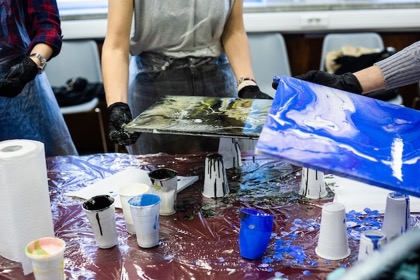Life can be super stressful, and let’s face it, adulting can be tough.
But have you ever considered turning to creative expression as a way to manage stress and boost your mental health?
Engaging in activities like art, music, and writing can help us process our emotions, reduce stress, and enhance our overall well-being.
So, let’s dive into the science behind the benefits of creativity for healing and find practical tips for incorporating creativity into our daily lives.
1. It Can Help Treat Mental Health Issues
Did you know that research has shown that creative expression can have significant benefits for mental health?
Yup, it’s true! A study published in the Journal of Positive Psychology found that engaging in creativity, like painting and drawing, can improve your mood, reduce stress, and increase feelings of well-being.
Another study published in the Journal of Art Therapy found that art therapy can be an effective treatment for those struggling with addiction. For this reason, it’s often used in alcohol and drug rehabilitation courses.
Programs like https://www.racnj.com/ encourage using creativity as one of your filters for a therapist who can help you include art in your healing journey.
2. It Sparks Joy
There’s just something magical about creating something with our hands. Whether it’s a painting, a piece of music, or a poem, the act of creation taps into a sense of play and curiosity that can be hard to access in other areas of life.
When we engage in creative activities, we allow ourselves to express ourselves in a way that feels authentic and fulfilling.
3. Music Can Be Medicine
Music is a powerful form of creating that has been used for centuries to support mental health and well-being.
Research has shown that listening to music can reduce anxiety, lower blood pressure, and even boost the immune system. Music therapy, a form of therapy that uses music to support healing and growth, has been used to treat a variety of conditions, including addiction.
So, next time you’re feeling blue, pop on your favorite tunes and let the music work its magic.
4. Art Therapy Lets You Express Yourself
Art therapy is a specialized form of therapy that uses art-making to support healing and growth. It can be particularly helpful for those struggling with addiction, trauma, and other mental health issues.
In art therapy, clients work with a trained therapist to create art as a means of expressing themselves and processing emotions.
Whether you’re creating art alone or in a group setting, art therapy can be a powerful tool in promoting mental health and well-being.
5. It’s Affordable and Easy to Integrate into Daily Life
One of the best things about creative expression is that it can be integrated into our daily lives in a variety of ways. Even if you don’t consider yourself “creative,” there are many simple ways to tap into your inner artist.
For example, you could try doodling in a notebook, singing in the shower, or taking a dance class. By finding small ways to incorporate creativity into your daily routine, you’ll be able to manage stress and promote mental health in a sustainable way.
One practical tip for integrating creativity into daily life is to create a dedicated space for creating. This could be a cozy corner of your bedroom, a desk in your living room, or even a small corner of a coffee shop.
Having a designated space for creativity can help you feel more inspired and motivated to create.
Final Thoughts
Art and other forms of creativity can be powerful tools for managing stress, reducing anxiety, and enhancing overall well-being.
The next time life gets a bit overwhelming, try turning to creative expression to tap into your inner artist and promote your mental health.
Remember, as Twyla Tharp writes in The Creative Habit, “Creativity is not a gift from the gods, but the result of preparation and effort.”



No Comments